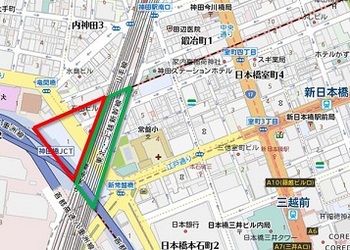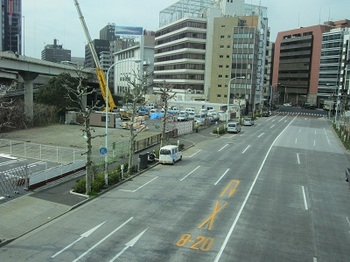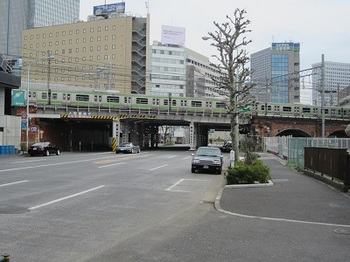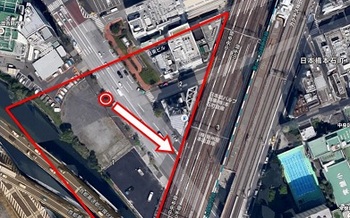[After first refuses to be maniac.![]() ]
]
Do you know this red triangle place in Chuo-ku?
If you expand it, it will be like this.![]()
The red triangle place is the only place in Chuo-ku "inside" of the Yamanote Line, if you use the expressions "inside" and "outside" of the Yamanote Line. It's 4-chome Nihonbashi Honishicho. By the way, one side of this red triangle is the trace of the Ryuka River, which once flowed into the Nihonbashi River (it became the border between Chuo-ku and Chiyoda-ku).
The part surrounded by greenery is Chuo-ku, the only place where trains run on the ground.![]()
Here, the JR Yamanote Line, Keihin Tohoku Line, Chuo Main Line, Tohoku / Joetsu Shinkansen run side by side. By station name, it's between JR Tokyo Station and Kanda Station.
And when I take a picture of this triangular place from the window of the running train, it looks like this.![]()
![]() The road is Sotobori-dori St., and the high speed at the left end is the Kanda Bridge Junction, where the Metropolitan Expressway Toshin Beltway and the Metropolitan Expressway Yaesu Line meet, and the Nihonbashi River flows below it.
The road is Sotobori-dori St., and the high speed at the left end is the Kanda Bridge Junction, where the Metropolitan Expressway Toshin Beltway and the Metropolitan Expressway Yaesu Line meet, and the Nihonbashi River flows below it.
Conversely, when you take a Yamanote line from a triangular location, it looks like this.![]()
The place where I took the picture above is here.![]()
Of course, there is no train station on the ground in Chuo-ku (although there are many stations under the ground![]()
![]() ).
).
That doesn't mean you don't have to be fooled.![]()
In Chuo Ward, there are Nihonbashikodenmacho and Nihonbashiodenmacho, which have been the center of land transportation since the Edo period, leaving the name of the traditional Japanese transportation system and the Ekiden horse system (no very persuasive![]() ).
).
![]()
![]()
![]()






